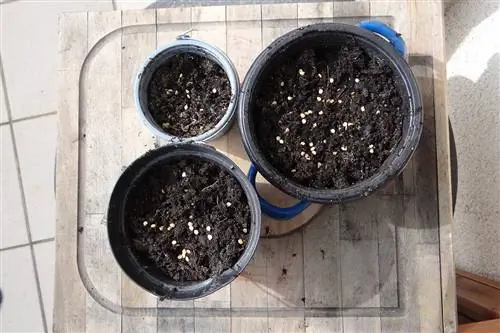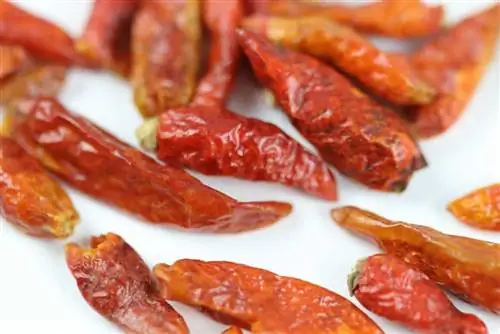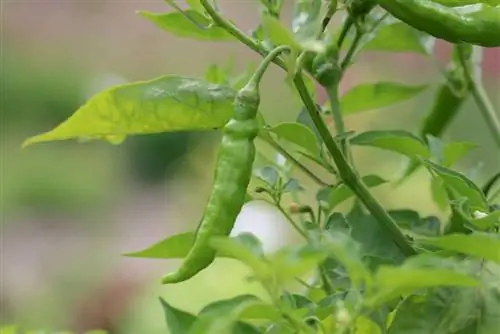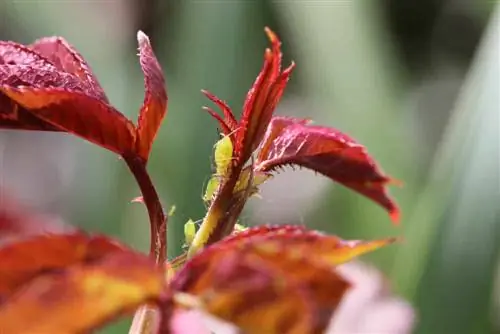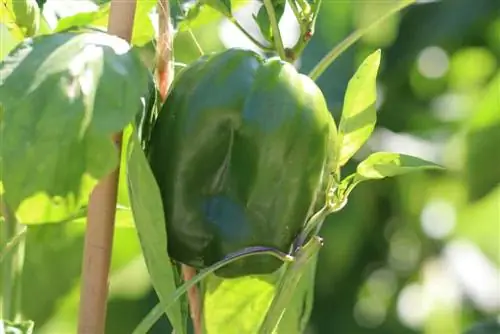- Author admin [email protected].
- Public 2023-12-17 03:39.
- Last modified 2025-06-01 06:48.
Due to the Central European climate, it is not possible to overwinter pepper plants outdoors. Frost is deadly to peppers, so they must overwinter indoors. You can find out more about overwintering pepper plants in this article.
Peppers in winter quarters
Many of the pepper plants that spent the summer on German balconies thanked us with their small, sweet fruits. Although the peppers you grow yourself from seeds or seedlings are not as large and fleshy as the ones from the supermarket, they are usually quite easy to grow and, in terms of taste, most varieties are worth it.
But when winter comes, the question arises for hobby pepper growers: What is the best way for peppers to overwinter? How do I get the plant through the winter so well that it will bear fruit again next year? - In principle, overwintering a pepper plant is not difficult - as long as the location and conditions are right:
- It should be clear: the balcony is not suitable for overwintering and surviving December and January without damage. Before the night frosts set in, the plant should move into its winter quarters.
- Before overwintering, it must be thoroughly examined for pests such as spider mites or aphids, otherwise these will multiply rapidly in the house and damage the plant.
- Bright places without drafts, possibly the hallway or a winter garden, are suitable as a location for overwintering. The temperature should be around 10°C.
Under these conditions, the plants continue to bear fruit just like in their homeland. It is advisable to regularly spray the top and bottom of the plant leaves with distilled water so that they do not suffer from the dry heating air and the pests are contained during the winter.
What should you consider when wintering?
In principle, all pepper varieties are suitable for overwintering. The advantage of overwintering is that the plants are even more productive in the second year. When overwintering peppers, be sure to follow the following steps:
- Check the plant for pests beforehand, if there are aphids or other pests, then remove them thoroughly
- Spraying the leaves regularly can protect the plant from pest infestation
- find a bright, slightly heated, but frost-free room for wintering
- Keep temperatures at the winter location at 10 °C, promote higher temperatures
- water only a little during the winter and do not fertilize
From the beginning of March, when the days get longer again, you can repot the peppers in larger pots with fresh soil. Now you should add a slow-release fertilizer that is suitable for tomatoes. In this way, the plants have the opportunity to sprout again. Furthermore, the plants must now be cut back.
Control of pests and diseases
The control of pests or diseases should be based on natural means and chemical means are only helpful in emergencies. In the long term, the use of chemical agents ensures that the natural balance is destroyed and the plant's natural defense system has no chance of becoming immune to the pathogens.
Aphids, for example, are best controlled by their natural enemies, the ladybird larvae. You can also spray the plants with some stale water and remove the lice with a small piece of wood.
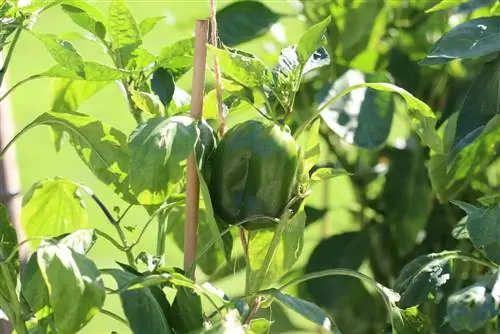
Powdery mildew can be recognized by the fact that a white fungal network forms on the surface of the leaves and the plant is deprived of important nutrients, causing the leaves to wilt. With downy mildew, greyish-bluish or purple spots form on the underside of the leaves, while bright yellowish mosaic-shaped spots become visible on the top of the leaves and the leaves increasingly die. Both fungal diseases can be controlled using the same method. To do this, remove the severely infected plants and compost them, because the fungus only dies in the compost. It is important to ensure good ventilation. In addition, from now on the plant should only be watered from below.
Care tips for wintering
The basic requirement for the successful overwintering of peppers is that the plants are free of diseases and pests. With regard to lighting conditions and temperature, you should choose a bright location that is not too warm or dry. It is also crucial to ensure proper air circulation and heat supply.
During the winter phase, the pepper plants should only be watered moderately and not fertilized. From February onwards, the first branches or nodes should be cut back. At the same time it is time to repot the plants and place them in a larger container. Now the plant needs to be watered regularly again and it should be warmer than before. When the nights are frost-free again, the pepper plant can go outside again. It's best not to plant the peppers back in the garden until after the Ice Saints. If you have a greenhouse, you can bring the pepper plants into the unheated greenhouse from the beginning or middle so that the first flower buds can sprout. Make sure that the plants are not planted deeper than in the cultivation pot, otherwise there is a risk that the plant will suffer from stem rot.
What types of wintering are there?
Wintering in a bright window and in a heated apartment
Before the plants are brought into the apartment to overwinter, they must be checked for pests. Spider mites can multiply quickly, especially in dry air. It is also an advantage if the plant, especially the underside of the leaves, is sprayed with distilled water at regular intervals. In this way, the pepper plant begins to bloom and bear fruit again.
Wintering in a bright and cool room
The temperature should be 10 °C and the air should not be too dry. In principle, the environment for overwintering should be bright and a location without drafts must be chosen. Even during the winter phase, the plant should be checked for pests and watered from time to time. Aphids in particular like to overwinter on the plants. Anyone who has missed an aphid can assume that the entire plant will be infected within a few days.
Conclusion
Pepper plants can overwinter either in a warm and bright location or in a bright but cool location. However, some important circumstances must be taken into account. Before overwintering, the pests must be removed from the plants so that they do not overwinter and cause damage to the plant. Furthermore, there must be no drafts at the chosen location. During the winter phase, the plants should only be watered lightly and not fertilized. If you overwinter your peppers well, you will be rewarded with a productive harvest the following year, because pepper plants are even more productive in the second year. Try it yourself and overwinter your pepper plant properly.
After wintering
Overall, the plant should be watered sparingly during the winter. In February you can slowly prepare the plant for the new outdoor year. First of all, it should be moved to a new pot shortly after overwintering.
But be careful: increase the diameter and depth just a little so that the plant doesn't waste all its energy on new, larger roots. Now the plant can move to another location that is slightly warmer than its winter quarters, but just as bright and draft-free. The substrate can now be a little moister and watering can be done more often. A little fertilizer is also good for the pepper plant. If everything works out, the peppers should produce bigger and better harvests in the second year.


